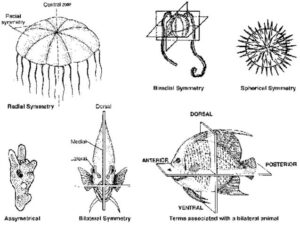Back to: ZOOLOGY 100 Level
It’s always such a joy to have you here. You’re not just learning—you’re growing, step by step, into a true star of science. Today, we’ll be looking at a very interesting topic: symmetry and body plans. Imagine walking into a tailor’s shop to sew a beautiful outfit. Before cutting the cloth, the tailor must measure and plan. That’s exactly how animals are “designed”—they have specific body plans, and many of them follow a pattern called symmetry.
Symmetry and body plans
What is Symmetry?
Symmetry simply means balance or having equal parts. In biology, symmetry is about how an animal’s body can be divided into equal halves. When an animal can be divided into similar sections, it means its body has symmetry. Think about how some things, like a butterfly, look the same on both sides when you fold them in half—that’s symmetry!

There are three main types of symmetry in animals:
- Radial symmetry: The body is arranged like the spokes of a wheel. You can cut through the centre in many ways and get equal halves. Animals like starfish and jellyfish have radial symmetry.
- Bilateral symmetry: This is when the body can only be divided into two equal parts—left and right—just like humans. Most animals, including dogs, goats, and fish, have bilateral symmetry.
- Asymmetry: Some animals do not have any symmetry at all. They are irregularly shaped, and you can’t divide them evenly. An example is the sponge.
What are Body Plans?
A body plan is the general structure of an animal’s body—how its parts are arranged. It’s like a blueprint for building a house. Body plans help scientists understand how animals grow, move, and function. They include features like:
- Body symmetry (as we’ve just discussed)
- Number of body layers (germ layers)
- Presence of body cavities (coelom)
- Segmentation (whether the body has repeating parts like in earthworms)
- Head and tail ends (cephalisation)
For example, a flatworm has a simple body plan with bilateral symmetry, no body cavity, and soft tissues. On the other hand, a grasshopper has a more complex plan—with clear head, thorax, and abdomen segments.

Importance of Symmetry and Body Plans
These features help animals survive and perform daily activities. For instance:
- Bilateral symmetry allows animals to move forward easily and have a head with sense organs.
- Radial symmetry is great for animals that stay in one spot but need to sense danger or food from all sides.
- Body plans determine how animals develop and adapt to their environments.
Summary
- Symmetry is the balanced arrangement of body parts.
- Radial symmetry allows multiple equal cuts, like in starfish.
- Bilateral symmetry allows only one equal cut—like in humans.
- Asymmetrical animals, like sponges, have no regular pattern.
- Body plans describe the organisation of body parts in animals and are used to group animals in biology.
Evaluation
- What type of symmetry does a starfish have?
- Give two animals that show bilateral symmetry.
- What does it mean if an animal is asymmetrical?
- Name one reason why body plans are important in biology.
Keep shining, superstar!
You’re becoming such a smart and thoughtful learner. Every time you understand a topic like this, you take one more step towards greatness. Stay confident and curious, and remember—Afrilearn is always here to support your learning journey. See you at the next exciting stop!
